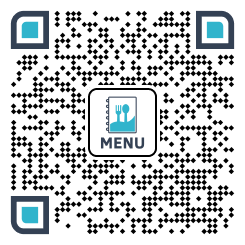Are you looking for food truck menu templates and ideas that make you stand out from the competition? You’re at the right place.
Your menu is the identity of your business that shows what you serve, and finds what they’re looking for. Therefore, this comprehensive guide will walk you through every aspect of creating a profitable food truck menu that attracts customers and maximizes your revenue.
What is a Food Truck Menu Template?
A food truck menu template is a pre-designed layout that helps food truck owners display their food offerings clearly and attractively. These templates are customizable, allowing you to add your dishes, prices, and branding elements like colors, logos, or food images.
Whether you’re serving tacos, burgers, or fusion street food, a well-crafted template helps you save time on design, stay consistent with your brand, and create a menu that’s easy for customers to read, especially when they’re in a hurry.
Using a ready-made template ensures your design looks professional, even if you don’t have a design background.
What are the Best Food Truck Menu Designs and Examples?
Struggling to design a menu for your food truck business? Here are some free menu templates and examples that make your food truck shine and increase profitability. Consider these examples as a design reference or customize any template to create your food truck menu.
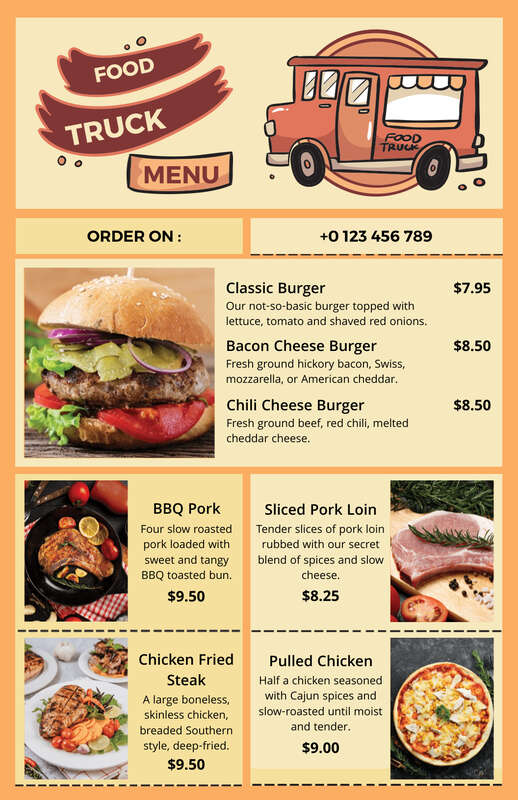
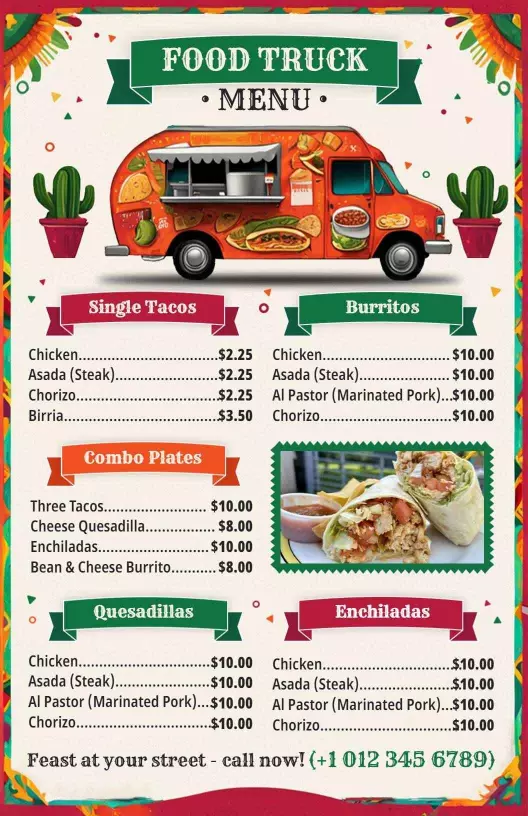
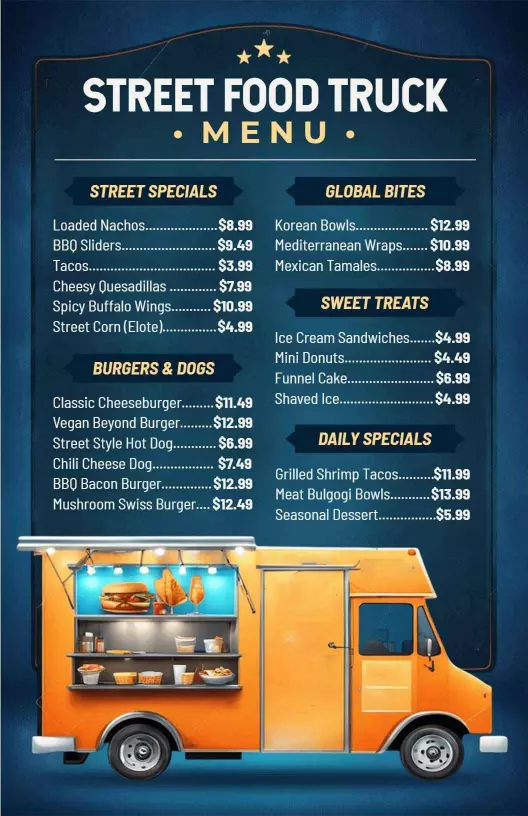
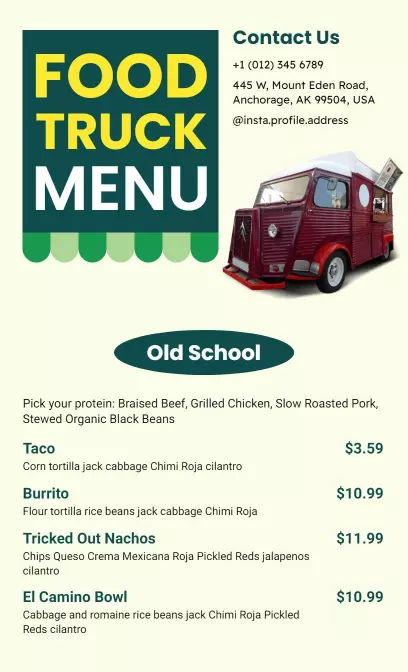
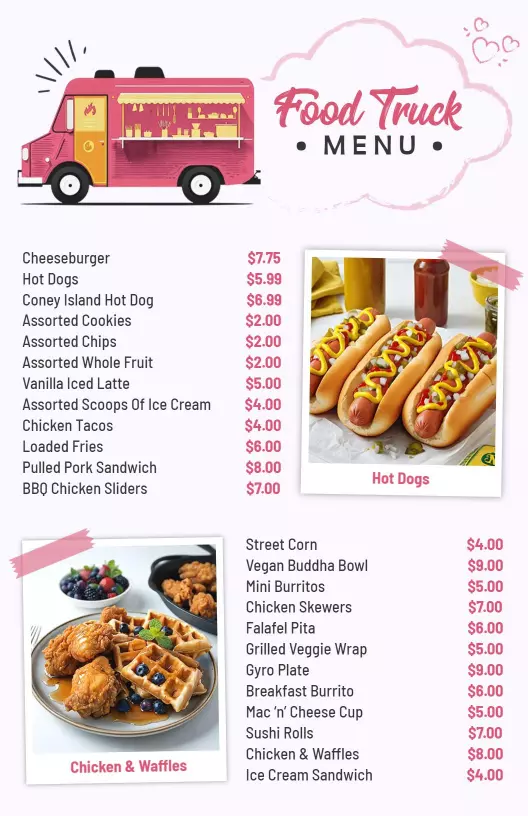
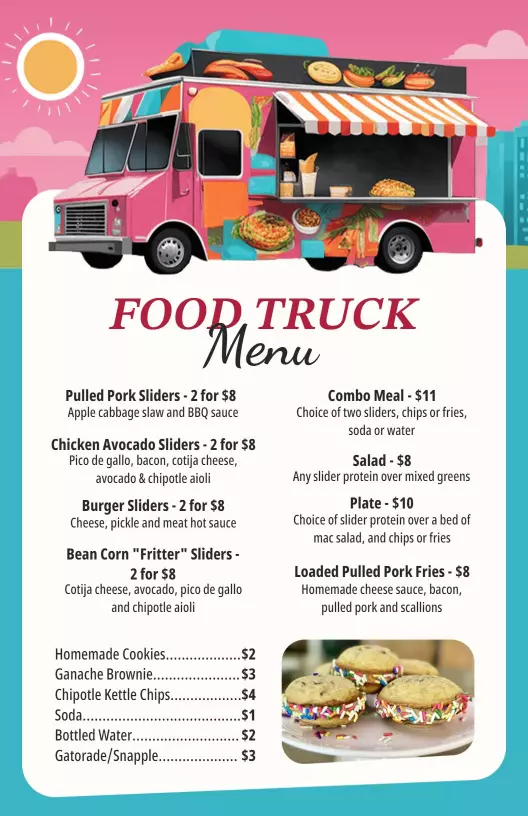
What Makes a Food Truck Menu Different from Restaurant Menus?
The process of creating restaurant menus is easier compared to food truck menus because it faces unique challenges. Specifically, mobile food businesses must consider space limitations, cooking equipment constraints, and the need for quick service. Additionally, food truck operators need menus that work efficiently in a compact kitchen environment.
Unlike restaurant menus, food truck menus must be:
- Streamlined for fast preparation
- Designed for limited storage space
- Optimized for mobile point-of-sale systems
- Easy to read from a distance
Moreover, your design ideas for menus play a crucial role in customer decision-making since people often have limited time to browse options.
How Do You Choose the Right Food Truck Menu Concept?
Selecting your food truck menu concept requires careful consideration of several factors. First, you need to analyze your target market and understand their preferences. Additionally, you must consider your culinary skills, equipment limitations, and startup budget.
Market Research and Target Audience Analysis
Start by researching successful food trucks in your area. Nevertheless, don’t simply copy their concepts. Instead, identify gaps in the market that your food truck menu can fill. Consider these questions:
- What cuisines are oversaturated in your market?
- Which demographic groups are underserved?
- What price points work best for your target customers?
- How do seasonal changes affect food preferences?
Concept Development Strategies
Once you understand your market, develop a unique concept that sets your food truck menu apart. Popular food truck menu concepts include:
Fusion Cuisines: Combining different culinary traditions creates unique menu items that generate buzz and social media attention.
Comfort Food Reimagined: Taking classic comfort foods and adding gourmet twists appeals to customers seeking familiar yet elevated experiences.
Health-Conscious Options: Offering nutritious, fresh ingredients attracts health-conscious consumers who struggle to find quality options from mobile vendors.
Regional Specialties: Bringing authentic regional dishes to new markets can create a loyal customer base craving authentic flavors.
What are the Types of Food Truck Menus?
A food truck menu isn’t just about what you cook — it’s about how you plan, serve, and change your dishes. Different food trucks use various types of menus depending on their style, goals, and customers’ behaviours.
Here are the main types of food truck menus you should know:
1. Fixed Menu
This type of menu stays the same every day. It features a curated selection of reliable, best-selling items. This type of food truck menu is best for brand-building, consistency, and repeat customers.
However, you risk limiting your customer base to people who want that specific type of food.
Pros:
- Easy to manage supplies and prep
- Customers know what to expect
- Builds a loyal following
Cons:
- Can feel repetitive over time
- Doesn’t adapt to seasonal ingredients
2. Rotating Menu
This menu changes regularly — weekly, monthly, or seasonally. The core theme stays the same, but specific dishes rotate. It is the best for creative chefs, seasonal cooking, or attracting new customers.
Pros:
- Keeps the menu fresh and exciting
- Let you use seasonal or local ingredients
- Appeals to adventurous eaters
Cons:
- Harder to manage inventory
- Some customers may miss their favorites
3. Customizable Menus
These trucks offer a base concept that customers can customize, such as build-your-own bowls, sandwiches, or salads. This approach satisfies different dietary preferences while keeping preparation streamlined.
Pros:
- Satisfies different dietary preferences
- People enjoy having control over their food choices
Cons:
- It takes longer service times
- Harder to ensure consistent taste and presentation of foods
4. Limited-Time Menu
This menu runs for a short time, usually at a festival, event, or holiday. It often features exclusive or themed dishes. This allows for faster service and better quality control. Limited menus also help reduce food waste and simplify operations.
Pros:
- Creates urgency (“get it before it’s gone!”)
- Great for marketing and social media
Cons:
- May confuse regular customers
- Requires extra planning
5. Fusion or Themed Menu
This menu blends different cuisines or follows a strong concept, like Korean-Mexican fusion or all-cheese dishes. These menus attract adventurous eaters and help trucks stand out in crowded markets.
Pros:
- Unique and memorable
- Great for branding
Cons:
- May need more explanation or marketing
- Riskier if the idea doesn’t catch on
If you’re sure about which types of food truck menu you should try, we’ve covered guide on it that you must check it out.
How Can You Make an Effective Food Truck Menu?
Creating a food truck menu requires careful consideration of several factors. First, you need to analyze your target market and understand their preferences. Additionally, you must consider your culinary skills, equipment limitations, and startup budget.
1. Market Research and Target Audience Analysis
Start by researching successful food trucks in your area. Nevertheless, don’t simply copy their concepts. Instead, identify gaps in the market that your food truck menu can fill. Consider these questions:
- What cuisines are oversaturated in your market?
- Which demographic groups are underserved?
- What price points work best for your target customers?
- How do seasonal changes affect food preferences?
2. Concept Development Strategies
Once you understand your market, develop a unique concept that sets your food truck menu apart. Popular food truck menu concepts include:
Fusion Cuisines: Combining different culinary traditions creates unique menu items that generate buzz and social media attention.
Comfort Food Reimagined: Taking classic comfort foods and adding gourmet twists appeals to customers seeking familiar yet elevated experiences.
Health-Conscious Options: Offering nutritious, fresh ingredients attracts health-conscious consumers who struggle to find quality options from mobile vendors.
Regional Specialties: Bringing authentic regional dishes to new markets can create a loyal customer base craving authentic flavors.
3. Design for Speed and Efficiency
Your menu should reflect dishes that can be prepared quickly. Avoid items that require long cooking times or complicated plating. Choose recipes that can be made in bulk or use overlapping ingredients. For example, tacos, burritos, and bowls can all share common elements like rice, beans, protein, and toppings. This reduces inventory waste and simplifies prep work.
4. Highlight Key Categories
Organize your menu into clear sections: mains, sides, drinks, and specials. If you offer vegetarian, vegan, or gluten-free options, label them accordingly. This helps customers decide quickly and improves their overall experience. You can also create combo meals to boost the average order value and offer convenience.
5. Test and Gather Feedback
Once your menu is live, observe what items sell best and which ones are ignored. Ask for customer feedback, especially if something is new or underperforming. Use this insight to refine your menu over time—add more popular dishes, remove slow movers, and experiment with weekly specials or limited-time items.
6. Include Prices Clearly
Don’t hide your pricing. Be upfront with costs so customers can make decisions quickly. Use whole numbers or round figures to keep it simple. You can also highlight value-for-money deals like meal combos or limited-time offers.
The list doesn’t end here. If you want to know the step-by-step details of how to make a food truck menu, read the guide we’ve mentioned here.
What Should You Include in Your Food Truck Menu?
Creating the perfect food truck menu requires balancing variety with operational efficiency. Therefore, you need to offer enough options to satisfy different preferences while maintaining quality and speed.
Additionally, consider the psychological aspects of menu design that influence customer behavior.
1. Core Menu Categories
- Signature Items: These are your star performers that define your brand and generate word-of-mouth marketing. Consequently, signature items should be unique, Instagram-worthy, and consistently delicious.
- Crowd Pleasers: Include familiar options that appeal to cautious eaters and children. However, put your own spin on these classics to maintain brand consistency.
- Profitable Add-ons: Sides, beverages, and desserts significantly boost your average order value. Moreover, these items often have higher profit margins than main dishes.
- Seasonal Specials: Limited-time offerings create urgency and encourage repeat visits. Furthermore, seasonal specials allow you to test new concepts without permanent menu changes.
2. Popular Comfort Foods with a Twist
People love familiar foods, especially if they come with a unique or unexpected twist. Think “Korean BBQ tacos,” “spicy loaded fries,” or “bacon mac and cheese burger.” This keeps things interesting while still giving customers a sense of comfort.
3. Vegetarian and Vegan Choices
A growing number of customers seek plant-based or dairy-free alternatives. Even one or two thoughtfully made options can go a long way in attracting these diners. Try offering a vegan burger, plant-based taco, or tofu bowl.
Avoid this mistake: Don’t offer bland vegetarian options as an afterthought. Put the same creativity into these items as you do with meat-based dishes.
4. Add-On Items and Extras
Add-ons and extras are one of the smartest ways to boost both customer satisfaction and profits on your food truck menu. They give your customers a sense of control and customization, allowing them to build their meal the way they want it, and that creates a more enjoyable dining experience.
For example, offering extra cheese, avocado, spicy sauces, bacon, or a side of seasoned fries gives people a way to personalize their meal.
5. Mention the Clear Ingredients of Items
Clearly listing the ingredients of each item on your food truck menu is essential for building trust, improving customer satisfaction, and reducing order errors. People want to know exactly what they’re eating—whether it’s due to allergies, dietary restrictions, personal preferences, or simple curiosity.
By describing foods in the menu using a few simple words, you help customers make quick, confident decisions. For example, instead of just listing “Spicy Chicken Wrap,” add a short line like: “Grilled chicken, spicy mayo, lettuce, pickled onions, and jalapeños in a toasted wrap.” This gives a full picture and builds interest.
6. Well-Designed Menu Display
Since food trucks often rely on curb appeal, your printed or digital menu must be clean, visible, and easy to read. Use large fonts, clear sections, and bright colors that match your truck’s theme.
Avoid this mistake: Don’t overcrowd the menu or use small, unreadable fonts. If people can’t read your menu from a distance, they may walk away.
How Can You Price Your Food Truck Menu Items Strategically?
Pricing your food truck menu requires understanding both your costs and customer psychology. Unfortunately, many food truck owners either underprice their items or set prices that seem arbitrary to customers. Therefore, strategic pricing becomes essential for long-term profitability.
Cost-Plus Pricing Method
Start by calculating your food costs for each menu item. Then, factor in labor, overhead, and desired profit margin. Generally, food costs should represent 25-35% of your menu price. However, this percentage can vary based on your concept and market positioning.
Psychological Pricing Strategies
Customers make quick decisions when ordering from food trucks. Consequently, your pricing strategy should facilitate easy decision-making while maximizing revenue. Consider these psychological pricing techniques:
- Anchor Pricing: Place your most expensive item prominently to make other prices seem reasonable by comparison.
- Bundle Pricing: Offer combination meals that provide perceived value while increasing average order size.
- Charm Pricing: Prices ending in 9 or 95 often feel more affordable than round numbers.
Competitive Analysis and Positioning
Research your competitors’ pricing to ensure your food truck menu remains competitive. Nevertheless, don’t engage in price wars that erode profitability. Instead, focus on providing superior value through better ingredients, larger portions, or unique recipes.
What Are the Essential Design Elements for Food Truck Menus?
Food truck menu design directly impacts your sales and customer experience. However, many food truck owners focus only on food quality while ignoring menu presentation. Therefore, understanding essential design elements helps you create menus that attract customers and increase profits.
1. Visual Hierarchy
Visual hierarchy determines what customers see first on your menu. Furthermore, proper hierarchy leads customers through a logical ordering process. Consequently, you can influence which items customers choose most often.
- Create Clear Visual Flow: Your menu should guide eyes from top to bottom naturally. Additionally, use size differences to show importance. For example, make signature items larger than regular options.
- Use Strategic Placement: Place high-profit items in prime viewing spots. Moreover, position these items in the upper right corner where eyes naturally go first. This technique increases sales of your most profitable dishes.
- Implement the Rule of Three: Group menu items in sets of three to make choices easier. Similarly, organize your entire menu into three main sections. This approach prevents customer overwhelm while maintaining variety.
2. Color and Typography Choices
In a food truck setting, your menu needs to grab attention quickly and be easy to read, even from a distance. That’s where color and typography play a powerful role.
Bright, bold colors can reflect your brand’s personality and draw eyes to your truck. For example, red and yellow are commonly used in food design because they trigger hunger and excitement.
On the other hand, typography is just as important. Use large, clear fonts that people can read quickly. Script or decorative fonts may look cool, but they often become hard to read in sunlight or on printed boards. Stick with bold, legible fonts for item names, and use slightly smaller text for descriptions or prices.
Check out this guide about typography and colors for menu design to know more about menu design principles.
3. Information Organization
Customers want to find information quickly when ordering from food trucks. Therefore, organize your menu logically and consistently. Additionally, group similar items together to simplify the decision-making process.
Category-Based Organization: Divide your menu into clear categories such as:
- Main dishes
- Sides and appetizers
- Beverages
- Desserts
Item Descriptions:
Write brief but appetizing descriptions for each item. However, keep descriptions under 15 words to maintain readability. Focus on key ingredients and cooking methods that differentiate your offerings.
Price Display:
Show prices clearly next to each item. Moreover, use consistent formatting for all prices. Avoid using dollar signs repeatedly, as this can make your menu look cluttered.
4. Attractive Visuals
Strategic use of visual elements makes your menu more appealing and memorable. However, too many graphics can distract from important information. Therefore, balance visual interest with clarity and functionality.
Photography Guidelines:
High-quality food photos can increase sales by up to 30%. Nevertheless, ensure photos accurately represent your actual food. Additionally, use professional photography or high-resolution smartphone images with good lighting.
Icons and Symbols:
Simple icons help customers identify dietary options quickly. For example, use recognizable symbols for vegetarian, vegan, or gluten-free items. However, limit icons to essential information only.
What Common Food Truck Menu Mistakes Should You Avoid?
Learning from common mistakes helps you create a more successful food truck menu from the start. However, these pitfalls can be costly if not addressed early in your planning process. Therefore, understanding these mistakes helps you make better decisions.
1. Overcomplicating Your Menu
New food truck owners often try to offer too many options, thinking variety equals success. However, extensive menus slow service, increase costs, and confuse customers. Additionally, complex menus strain kitchen operations and increase the likelihood of errors.
2. Ignoring Profit Margins
Focusing solely on customer satisfaction without considering profitability leads to business failure. Therefore, every menu item must contribute to your bottom line. Moreover, understanding food costs and pricing helps you make informed decisions about menu composition.
3. Neglecting Dietary Restrictions
Modern consumers increasingly seek options that accommodate dietary restrictions and preferences. Consequently, food truck menus should include vegetarian, vegan, gluten-free, or other specialized options. However, ensure that these alternatives align with your concept and capabilities.
4. Poor Menu Communication
Unclear descriptions, confusing pricing, or illegible displays frustrate customers and reduce sales. Therefore, invest in professional menu design and clear communication. Additionally, train staff to explain menu items accurately and enthusiastically.
How Do You Test and Refine Your Food Truck Menu?
Continuous testing and refinement ensure your food truck menu remains competitive and profitable. However, making changes too frequently can confuse customers and increase costs. Therefore, develop a systematic approach to menu evaluation and improvement.
Performance Metrics and Analysis
Track key metrics to understand your menu’s performance:
- Sales volume by item
- Profit margins per dish
- Customer feedback and preferences
- Preparation time and complexity
- Ingredient costs and waste
Customer Feedback Integration
Actively seek customer feedback through surveys, social media, and direct conversations. However, balance customer requests with operational feasibility and profitability. Moreover, consider the source and frequency of feedback when making decisions.
A/B Testing Strategies
Test menu changes systematically by implementing modifications gradually. For example, introduce new items as specials before adding them permanently. Additionally, test different pricing strategies or descriptions to optimize performance.
What Technology Tools Can Enhance Your Food Truck Menu?
Modern technology offers numerous tools to improve your food truck menu’s effectiveness and management. However, choose technologies that solve specific problems rather than adopting tools for their own sake. Therefore, focus on solutions that improve customer experience or operational efficiency.
Digital Menu Solutions:
Using a QR code menu provides flexibility and reduces printing costs. Additionally, designing digital menus for restaurants allows for real-time updates and integration with ordering systems. However, ensure that digital solutions don’t create barriers for less tech-savvy customers.
Point-of-Sale Integration:
Modern POS systems can track menu item performance and provide valuable analytics. Furthermore, integrated systems streamline operations and reduce errors. However, choose systems that work reliably in mobile environments.
Social Media Integration:
Use social media to showcase your food truck menu and build customer engagement. Specifically, platforms like Instagram and Facebook allow you to highlight daily specials and seasonal items. Moreover, social media provides valuable feedback and marketing opportunities.
What Are the Future Trends in Food Truck Menu Development?
Understanding industry trends helps you plan for the future and stay ahead of competitors. However, not every trend will suit your specific concept or market. Therefore, selectively adopt trends that align with your brand and customer base.
Health and Sustainability Focus
Consumers increasingly prioritize health and environmental sustainability. Consequently, food truck menus that emphasize fresh, local, and organic ingredients appeal to conscious consumers. Moreover, sustainable practices can differentiate your brand in crowded markets.
Technology Integration
Advanced ordering systems, mobile apps, and automated preparation tools are becoming more common. Furthermore, these technologies can improve efficiency and customer experience when implemented thoughtfully.
Customization and Personalization
Customers appreciate the ability to customize their orders to personal preferences. Therefore, design your menu to accommodate modifications while maintaining operational efficiency. Additionally, personalization options can increase customer satisfaction and loyalty.
Locally Sourced and Seasonal Ingredients
Using fresh, local, and seasonal ingredients not only enhances taste but also supports sustainability. Customers today care about where their food comes from. Rotating menu items with the seasons also keeps your offerings fresh and exciting.
Don’t rely too much on ingredients that are hard to source year-round. Choose local ingredients that are available consistently or plan rotating dishes accordingly.
How Do You Optimize Your Food Truck Menu for Operations?
Operational efficiency directly impacts customer satisfaction and profitability. Therefore, your food truck menu must work within the constraints of your mobile kitchen. Additionally, consider how menu complexity affects service speed and food quality.
- Kitchen Workflow Optimization: Design your menu around your kitchen’s capabilities and limitations. Specifically, consider these operational factors:
- Equipment Utilization: Maximize the use of your existing equipment rather than adding menu items that require additional appliances.
- Prep Time Requirements: Balance fresh preparation with advanced prep to maintain quality while ensuring fast service.
- Storage Limitations: Choose ingredients that store well and serve multiple menu items to optimize space usage.
- Cooking Time Coordination: Ensure that items can be prepared simultaneously without overwhelming your kitchen capacity.
What Role Does Seasonality Play in Food Truck Menu Planning?
Seasonal menu planning keeps your food truck menu fresh and relevant throughout the year. Moreover, seasonal ingredients often cost less and taste better than out-of-season alternatives. However, seasonal changes require careful planning to maintain operational efficiency.
Seasonal Ingredient Integration
Incorporate seasonal ingredients into existing menu items rather than completely changing your offerings. This approach maintains customer familiarity while showcasing fresh, quality ingredients. Furthermore, seasonal modifications can create social media buzz and encourage repeat visits.
Limited-Time Offerings Strategy
Seasonal specials create urgency and excitement among customers. Additionally, limited-time offerings allow you to test new concepts without permanent menu changes. However, ensure that seasonal items align with your brand identity and operational capabilities.
Food Truck Menu – FAQs
1. What is a food truck menu called?
A food truck menu is a list of dishes with names, ingredients, pricing, and images. It is often displayed on a physical board, either on the side of the truck or inside, showcasing the available items for customers. It streamlines the order process and increases the profitability of the business.
2. How many items should be on a food truck menu?
The ideal food truck menu typically includes 8-12 items total across all categories. However, this number depends on your kitchen size, staff capacity, and concept type. Moreover, successful food trucks often limit main dishes to 5-7 options while adding 2-3 sides, beverages, and dessert choices.
3. What makes a food truck menu profitable?
A profitable food truck menu balances high-margin items with customer favorites. Specifically, focus on ingredients that work across multiple dishes to reduce waste and inventory costs. Moreover, items with food costs between 25% and 35% of the selling price typically generate healthy profits.
Additionally, profitable menus include strategic add-ons like beverages, sides, and desserts that boost average order value.
4. How often should you update your food truck menu?
Update your core menu items seasonally or quarterly to keep offerings fresh and take advantage of seasonal ingredients. However, avoid changing your entire menu frequently, as this confuses regular customers and increases operational complexity. Moreover, successful food trucks often introduce limited-time specials weekly or monthly while maintaining consistent core offerings.
5. How do you handle dietary restrictions on food truck menus?
Mark items that accommodate common dietary restrictions using recognizable symbols or text indicators. Moreover, train your staff to answer detailed questions about ingredients and preparation methods. Additionally, consider offering at least one option each for vegetarian, vegan, and gluten-free diets.
6. What types of menus do food trucks typically offer?
Food trucks typically offer a variety of menu types, including signature menus focusing on a few core items, fusion menus combining different cuisines, seasonal or rotating menus based on availability, specialty menus catering to dietary needs, and combo menus designed for larger groups or families. The choice depends on the brand, goals, and the customer’s behaviour.
7. What should I look for in a food truck menu template?
Choose templates that are easily customizable for your specific food items and brand colors. Moreover, ensure the template includes space for item descriptions, prices, and dietary indicators. Additionally, you can use a free menu maker that provides plenty of templates designed specifically for food trucks with high contrast and large fonts.
8. Are free food truck menu templates worth using?
Free templates can work well for startups with limited budgets, but they often lack professional polish and customization options. Moreover, many businesses use the same free templates, making your menu look generic. However, free templates provide a good starting point that you can modify with design software.
9. What are the Most Popular Food Truck Items for Menus?
Food truck menus are diverse and constantly evolving, but there are a few tried-and-true items that remain incredibly popular due to their portability, flavor, and ease of preparation. Some of the most popular food truck items include:
- Tacos
- Burgers
- Barbecue
- Fusion Foods
- Pizza
- Desserts
These items keep customers coming back for more, and their portability makes them perfect for food trucks.
10. What size should my food truck menu be?
When deciding the size of your food truck menu, it’s important to find the right balance between variety and simplicity. A menu that’s too large can overwhelm customers and complicate your operations, while one that’s too small might limit your appeal. Ideally, aim for 8-15 items, focusing on a few signature dishes or specialties that highlight your food truck’s identity.
Conclusion
This guide covers everything you need to know about food truck menus, their design concepts, examples, and more.
Remember that your food truck menu is never truly finished. Instead, it should evolve based on customer feedback, seasonal changes, and market conditions. Additionally, regular evaluation and adjustment ensure that your menu continues to drive profitability and customer satisfaction.


